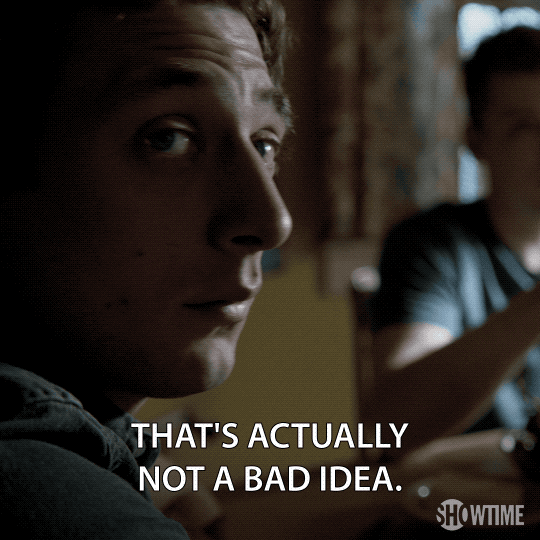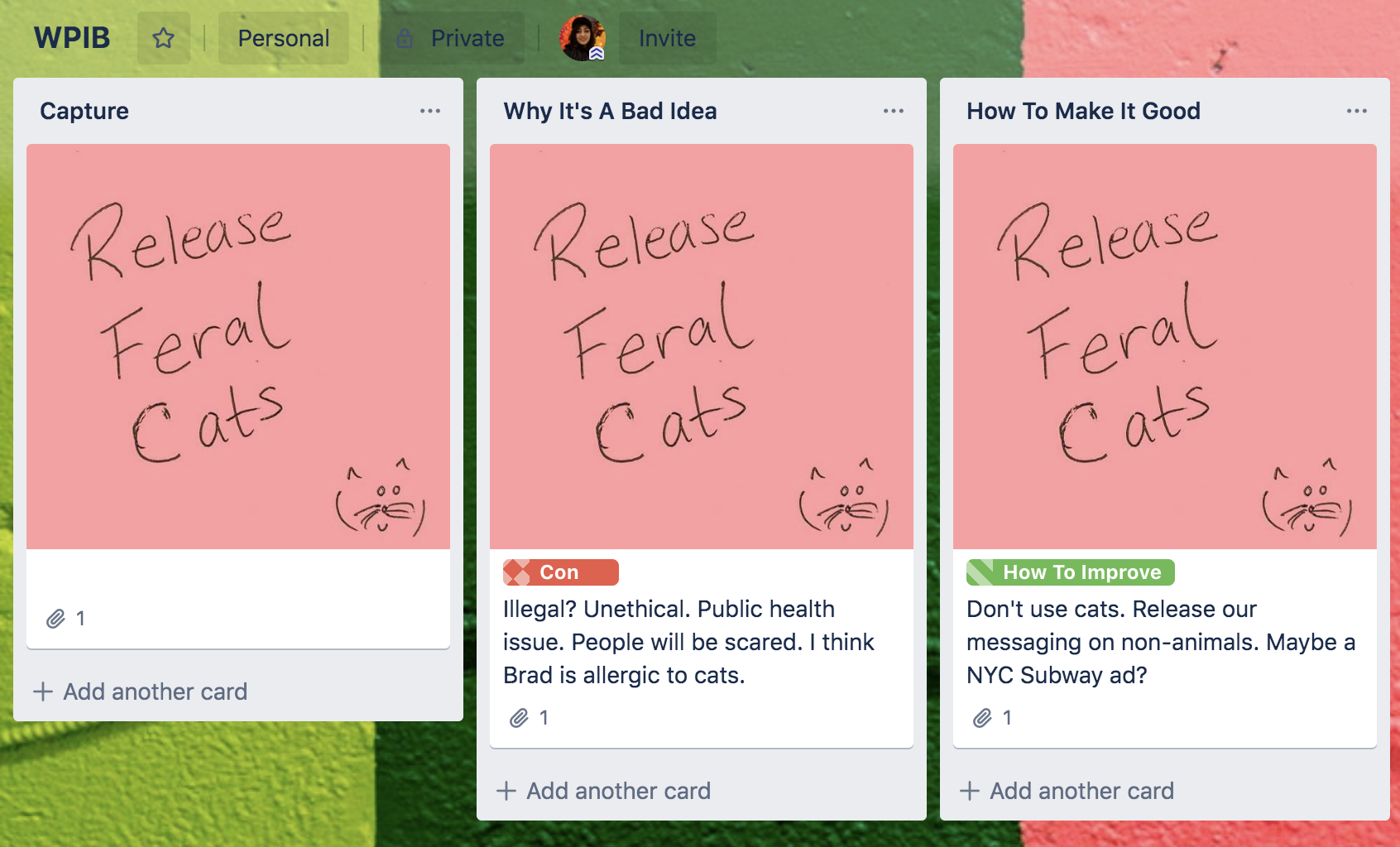You’ve gathered your favorite coworkers into a meeting—it’s time to brainstorm bright and brilliant ideas for your company’s next major campaign:
“Let’s do a campaign entirely in Comic Sans!”
“How about hiring that clown from my son’s birthday party as a spokesperson?”
“I think releasing 200 feral cats on the NYC Subway would really make an impact.”

This isn’t an excerpt from your latest nightmare, it’s your team participating in a ‘Worst Possible Idea’ brainstorm, or what I like to affectionately call them, a WPIB.
Most of us have experienced, or even conducted, a typical brainstorm where we’re all pressed for ideas and ultimately, and somewhat chaotically, land on a few ideas we think are worth…something.
The truth is, brainstorms aren’t always effective—with a goal that’s as broad as, “let’s talk good ideas,” participants not only tend to shush up because they perceive others as “more experienced” but they also suggest more mediocre ideas than if they had time to actually sit down and think.
So why would a WPIB be any different?
Brainstorms That Are Bad To The Bone
The main difference between trying to conjure a good idea vs a terrible idea, is the pressure.
Trying to solve a problem feels epic, perhaps even noble—so when we try to whip up a solution it feels like a lot is at stake. Whereas, a terrible idea, why, a terrible idea is something we can immediately recognize when we see one! The cinnamon challenge, the tide pod challenge, most challenges, really, we can sense the terribleness from miles away.
The thing with bad ideas is that they’re usually easier to identify and way easier to concoct.
There are just so many more ways we are able to fathom something going wildly wrong rather than it going perfectly. That being said, gathering together to coop up ideas that are straight nonsensical really helps take the pressure off.
If the goal of the meeting is to mutually agree on a terrible idea, not only will there be laughs (and quite possibly the most fun meeting of your entire week) but it may also help align your team on exactly what it is you don’t want to achieve.
Tap Into Those Guilty Pleasures
It’s no secret we’re not having fun when we’re feeling stressed, and it’s also not surprising that stress isn’t exactly the best companion when we’re trying to get creative. Which is why one of the most important reasons why your next meeting should be a WPIB is that, quite simply, it’s a boat-load of fun!
Besides being enjoyable, a WPIB acts as the ultimate ice-breaker when you’re meeting with a new team or even helps reacquaint coworkers to one another’s goofy sides. Giving your team a safe space to be openly goofy and blow off steam from their everyday roles can do wonders for team morale in the long run.
So, give your coworkers a chance to shine, in all their terrible-idea glory.

N*SYNC Inspiration
All brainstorms start out vague, “We need a new angle to get more sign-ups” or “The best way to raise $5,000”. The nature of brainstorms is to create a goal and expect attendees to blurt out brilliant ideas. But how can you be sure that everyone truly understands what you’re trying to achieve?
It’s easy, with a WPIB, everyone will be blurting out ideas that are the exact opposite of what you need. Worst case scenario, someone will say something that oddly aligns with your goals and hey, you have one good idea!
While unorthodox, aligning your team on what it is exactly that you DO NOT want to achieve, makes the end goal that much clearer.
After sharing your plethora of terrible thoughts, it’s helpful to poke at each idea and really dissect what’s wrong with it and even if the basis of the idea has any merit. More often than not, this leads to an actual brainstorm.

“What if instead of releasing 200 feral cats on the NYC Subway, we did have some sort of way to spread the message during a daily commute?”
“How about instead of focusing on Comic Sans as a font, we still do a campaign focused on 90’s themed design? Tap into nostalgia!”
Exploring the silly side has the potential to transform your team.
So How Exactly Does This Work?
A great way to get started on your WPIB is to split it up into two separate parts:
- Ideation spit fire
- Breaking it down
During the “Ideation spit fire” stage, have an assigned scribe taking note of all the ideas being talked about while the meeting lead encourages participants to have an open discussion.
The scribe can write ideas down on Post-It® Notes and stick them up on the wall. If ideas have a theme, they can be easily grouped by moving the notes around. These groups are part of the “Ideas” phase.
Once all your terrible ideas are down on paper, you can take things to Trello to vote up the most compelling, and prep them for the next steps.
Grab your mobile device and get ready to take a picture (not just for memory’s sake) in order to automagically transfer your handwritten Post-ItⓇ Notes onto a Trello board.
Here’s how:
- Download the Post-it® App (For iOS and Android)
- Take a picture of your Post-It® Notes that were a part of your latest WPIB session
- Tap the “export to Trello” button
- Revel in the technological feat you just accomplished ✨
A brand new Trello board will have been created with all of your digitized Post-It® Notes as Trello cards. Which is great news because you have all your handwritten thoughts in one easy-to-read, shareable board.
Once the Post-It® Notes are transformed into Trello cards, each member of the brainstorm can then vote on their favorite ideas from that day’s session using the Voting Power-Up. After each person votes for their top 3-5 ideas, you can sort the list by “Most Votes” and see which ones will go on to the next round.
No matter where or how you document your ideas, it’s important to keep track of what the team is coming up with you can extract themes when you enter phase 2: “Breaking it down”
The breakdown phase sorts the options into a three-part framework:
- Ideas capture
- Why it’s bad
- How to make it a good idea
Your team can really dig into the ideas the group had by using the following setup:

As the Post-It® Notes will appear on your board as cards, you can copy them into new lists that mimic the three-part framework. Because your group’s written idea is already the main image of that card, you can change the title of each card to notes/ideas that your team comes up with.
A good way to stay organized is to use labels in order to easily avoid confusion as to whether or not a card was actually an explanation of why it’s a bad idea or belongs in the “How To Make It Good” list. In this example, we’ve used red and green labels to create a visually simple framework within a Trello board.
As you collected the ideas on Post-It® Notes, they probably fell naturally into categories. Group similar ideas then, as a team, discuss what elements make those ideas truly terrible.
The legality of the idea might be questionable, it might even be straight up mean, and in most cases, the worst ideas are the ones that tend to go against your company values and brand (if not the law). That’s where you can begin addressing the third column, “How to make it a good idea.”
Flip your WPIB thoughts into a “Best Possible Ideas Brainstorm, or a BPIB, using this simple grid. Picking apart each thought and searching for its potential can be the start of your latest, and greatest, campaign.
Tackle Those Fears
Aside from the fun you will inevitably have during a WPIB, the larger hurdle you are tackling are those fears we all have when presenting ideas or starting a new project.
The first step to overcoming a fear is to acknowledge it, and with your team in tow it’s easier together than by yourself.

Get your keyboards ready, those brains fired up, and prepare yourself to unexpectedly consider the merits of releasing a million ping pong balls at your local mall.
Next: From Ideas To Action: How To Turn Post-it Notes Into Trello Cards










































